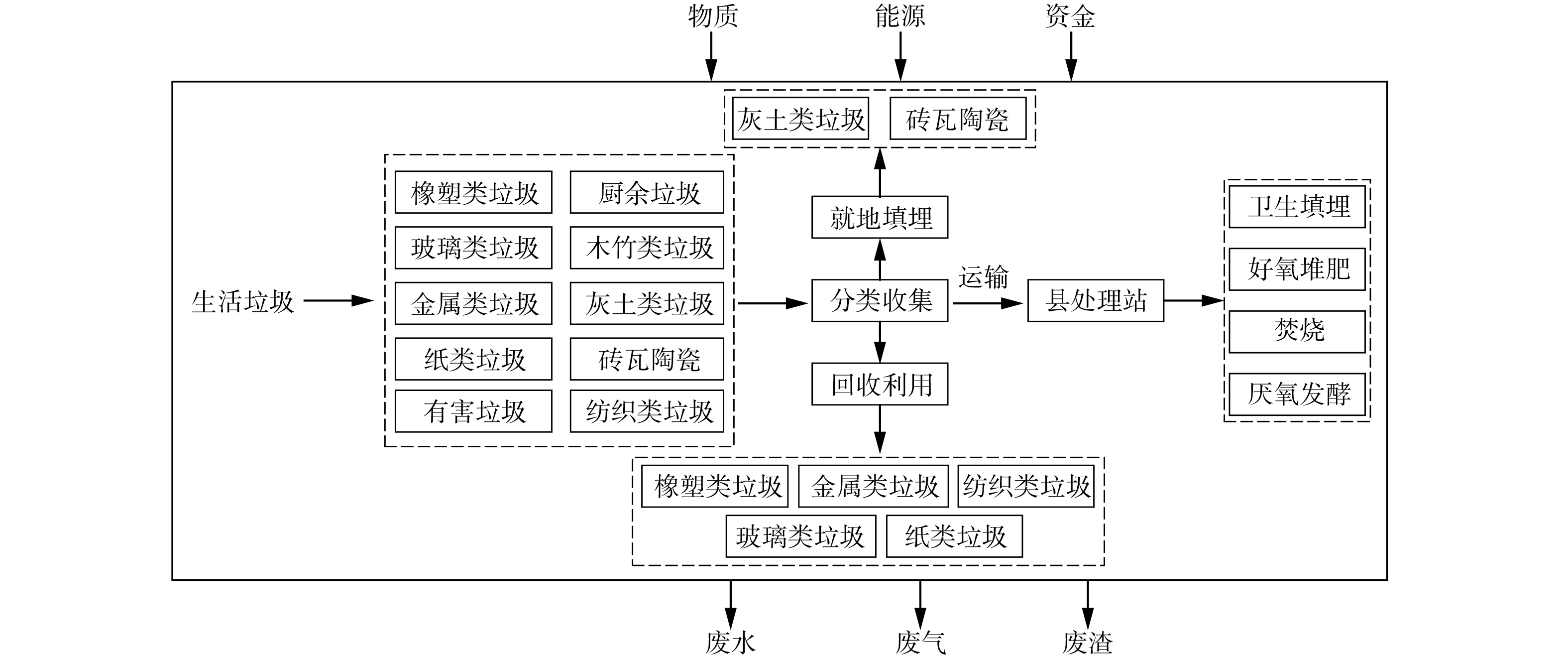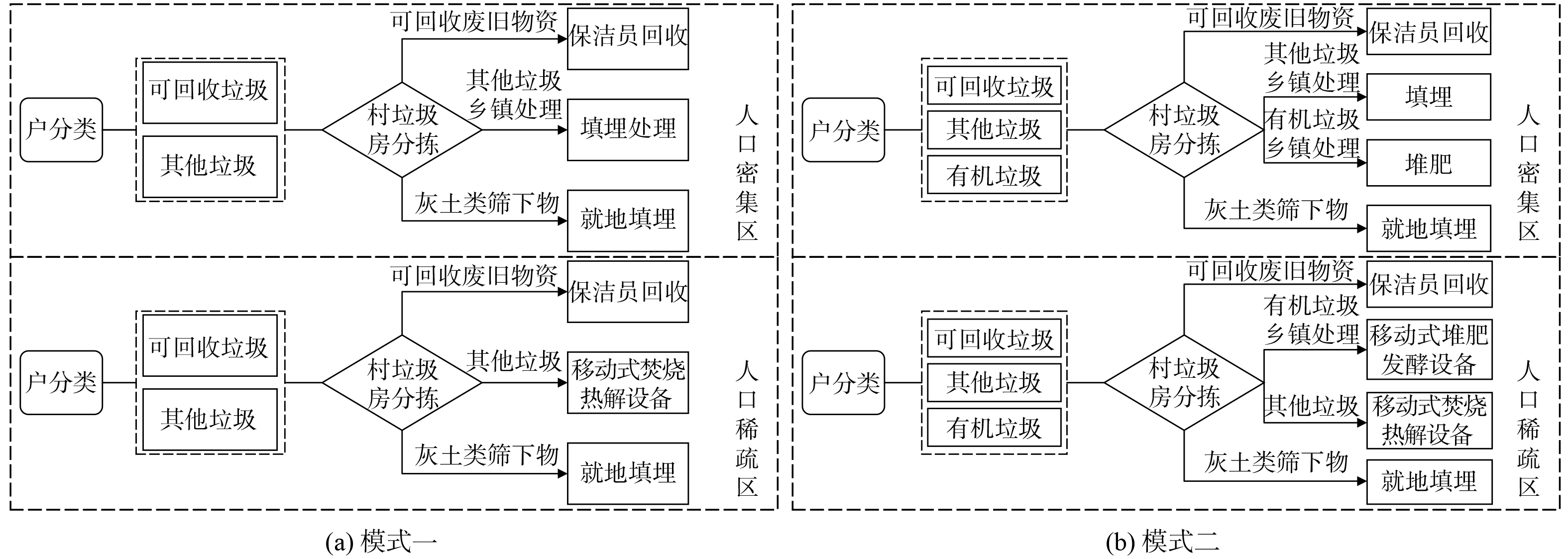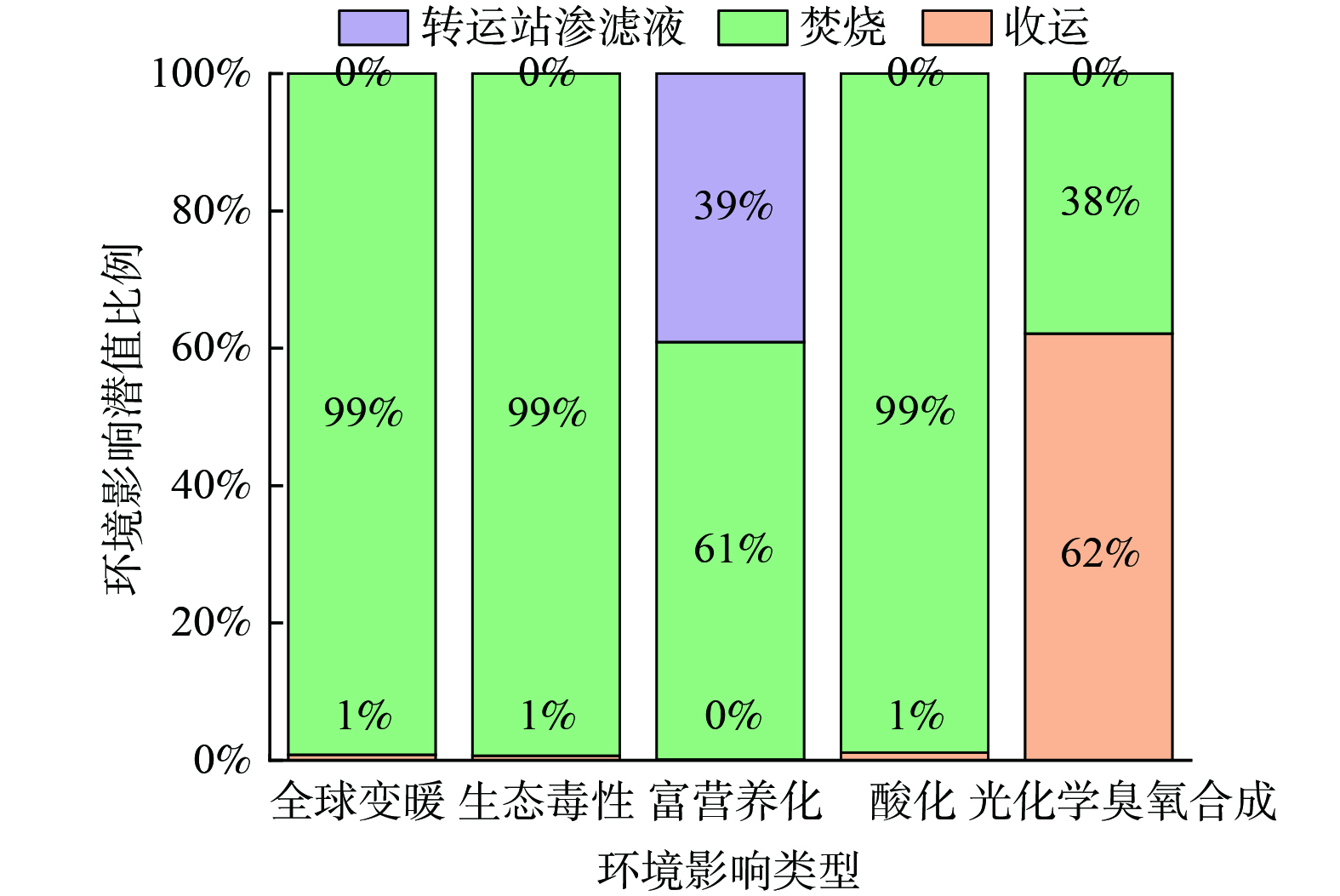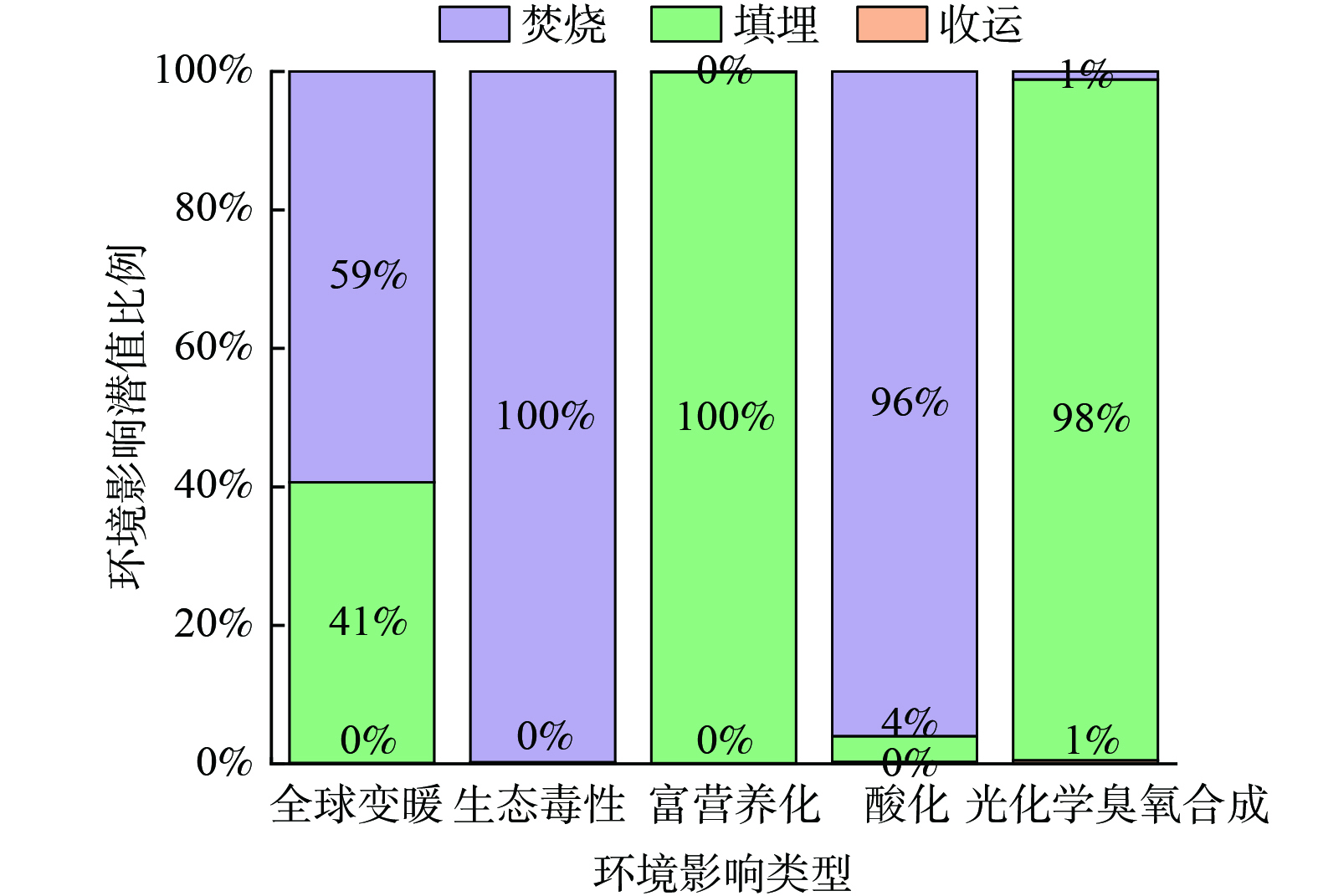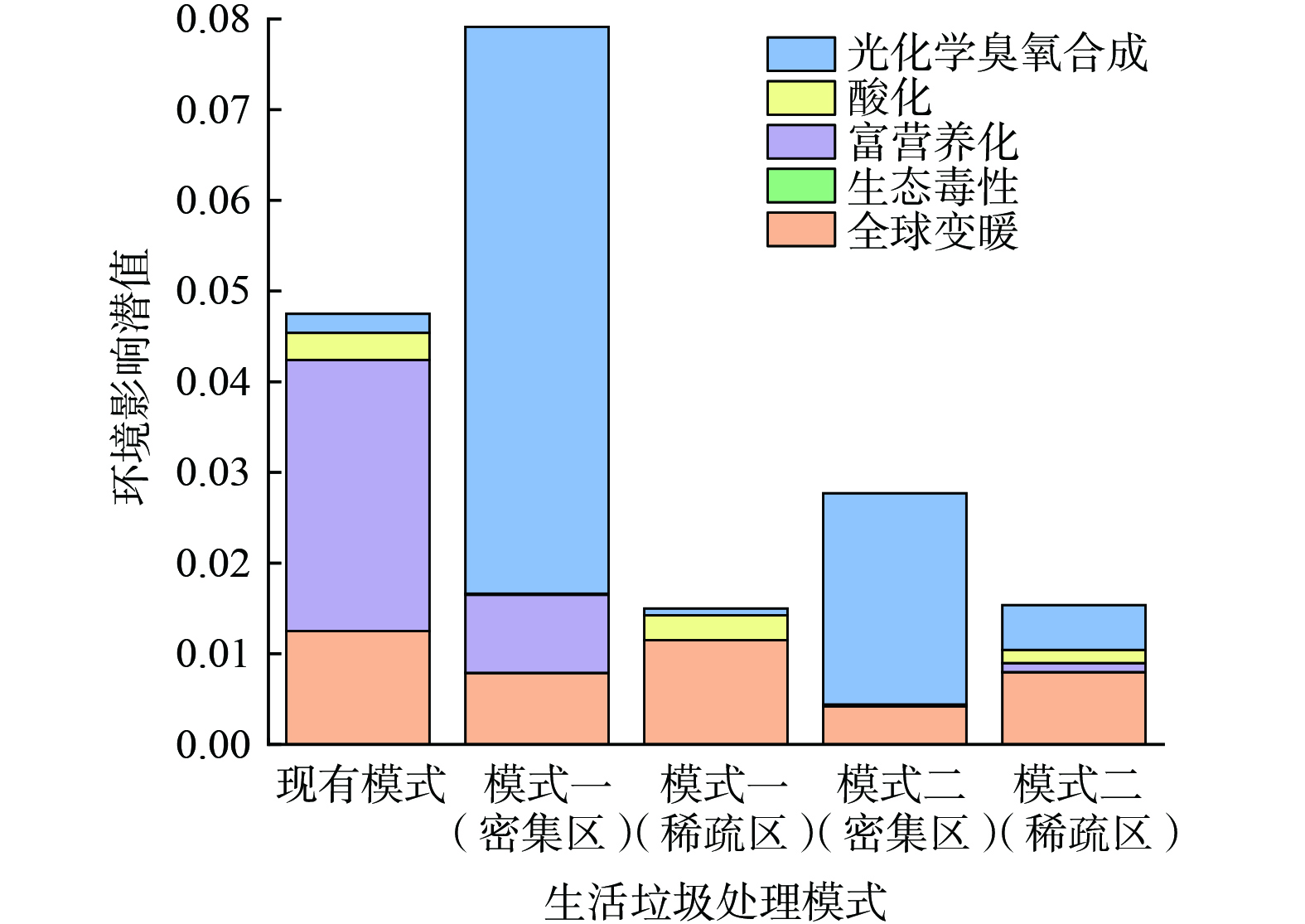-
过去,由于经济上的制约和村镇居民的消费能力较低,村镇生活垃圾中的塑料、橡胶、有害垃圾等垃圾组分含量不高,因此生活垃圾对村镇生态环境的危害相对较低[1-3]。然而,近年来随着城市化进程的加快和人民生活水平的提高,村镇生活垃圾产量以每年8%~10%的速度持续增长。据统计,2020年我国村镇生活垃圾产生量约为2.62×108 t,但城市垃圾清运量仅为2.35×108 t [4]。若生活垃圾不能及时处理或处置不当将会引发一系列环境问题,例如堆积的垃圾将占据土地资源,破坏自然景观,并影响生态系统的完整性和美观性;此外,未经妥善处理的垃圾会产生恶臭、吸引害虫和病菌滋生,增加疾病传播的风险,对公共卫生构成威胁。这使得村镇生活垃圾的污染问题成为建设无废城市过程中亟待解决的重要问题之一[5],因此如何选取1个适宜当地且对环境友好的村镇生活垃圾处理模式至关重要[6]。
在选择村镇生活垃圾的处理模式时应充分考虑各种影响因素[7],例如西部和东北地区农村人口较为稀疏,农户居住相对分散,将导致村镇生活垃圾的收运难度和无害化处理成本增加;而中部和东部地区农村人口较为密集,更适合采用“村收集-镇转运-市 (县) 处理”的模式;同时不同地区居民的生活习俗也会影响垃圾产量及其组分特征,进而影响该地区的村镇生活垃圾处理模式的选择。因此,根据各地区实际情况因地制宜的选择合适的垃圾收运处理模式,可以有效降低垃圾收运处理成本,缓解当地政府财政压力,并对提高村镇生活垃圾无害化处理率,改善村镇生态环境具有重要意义。
全生命周期评价(full life cycle assessment, FLCA)起源于20世纪60年代,在经过60余年的发展后逐渐成为了21世纪最具有前景的生态环境管理工具[8-9],该评价方法可以对1个产品从产生到最终处置的全过程涉及的环境影响进行分析[10-13]。在垃圾处理领域内,已经有诸多国内外学者利用该方法进行研究,评价内容主要有各类垃圾的卫生填埋、简单填埋、焚烧处理、无害化处理、资源化利用等[14-15]。例如,潘国清等[16]采用LCA对厨余垃圾厌氧发酵产沼气发电技术对资源环境的影响进行评估分析;陈冰等[17]基于LCA对生活垃圾的3种综合处理模式在环境、经济等方面进行综合评估,并得出了“分类+焚烧+生物”的综合处理模式在评估范围内更具有优势;CHEN等[18]基于LCA合算了上海市生活垃圾分类后不同模式下的碳排放贡献;张慧等[19]采用传统生命周期和㶲生命周期2种评价方法对4类典型的厨余垃圾处置利用技术的环境负荷及能量转化进行定量评估;纪丹凤等[20]通过研究北京市不同的生活垃圾焚烧处理方案,得出了生活垃圾进行湿法处理的总环境影响潜值最小,但其资源耗竭系数最大的结果。此外,国外有学者采用LCA对生活垃圾的收运过程进行了环境影响核算和经济评估[21-22],但国内涉及生活垃圾收运方面的LCA研究较少。使用FLCA可以高效且全面的评价并分析村镇生活垃圾处理模式中各个过程对环境影响[6,23-25],并根据评价结果选用合适的村镇生活垃圾处理模式。
该研究选取湖北麻城市的密集型村镇作为研究对象,在原有垃圾处理模式上新提出了2种适用于当地村镇生活垃圾收运处理的模式,并使用FLCA进行环境影响评估,包括确定全生命周期边界、污染物排放清单、污染物排放途径和环境影响潜值核算。该研究通过FLCA对典型密集型村镇的不同生活垃圾处理模式进行环境影响评估,定量化的描述了村镇生活垃圾从产生到最终处置过程中对环境的影响,弥补了我国在村镇生活垃圾处理模式领域的全生命周期研究以及生活垃圾收运方面研究的不足,对建设无废城市具有一定的价值和现实意义。
-
根据国际标准化组织ISO 14040系列标准,将麻城市村镇生活垃圾收运处理全过程的FLCA分析分为目标和范围定义、清单分析、影响评价和结果解释4个步骤。
-
1) 麻城市的村镇生活垃圾产量与组分。该研究在麻城市龟峰山风景区、铁门岗乡、白果镇进行生活垃圾采样。如图1所示,麻城市的村镇生活垃圾中含量最高的4类分别是厨余、灰土类、橡塑类和纸类,其组分及含量与全国平均值接近,这为全国范围内密集型村镇居民生活垃圾处理模式的建立提供一定的科学依据。经现场统计及检测,麻城市的村镇生活垃圾日均产生量约为510 t,村镇生活垃圾低位热值约为5 884.6 kJ·kg−1,容重约为230.4 kg·m−3,含水率为60.89%。
2) 麻城市村镇生活垃圾处置系统现状。麻城市垃圾焚烧发电厂位于歧亭镇官塘村,距离歧亭镇中心城区约3.0 km,该厂日处理量为1 200 t·d−1,主要服务于麻城市和新洲区的村镇生活垃圾,焚烧产生的热量用于焚烧与制砖,残余炉渣经处理后运往填埋场。麻城市中馆驿镇区域性生活垃圾填埋场总用地规模约168.7亩,总库容量7.207×105 m3,设计近期日处理垃圾425 t。目前,麻城市采用“村收集-镇转运-县处理”的方法对村镇生活垃圾进行收运处理。
-
该研究的数据来源于麻城市村镇实地调研结果及相关文献。环境影响评价模型的建立如表1所示。
-
1) 功能单位及生命周期边界确定。该研究的表征参数来自于国际气候变化专家委员会 (intergovernmental panel on climate change, IPCC) 研究报告[13],分析了全球变暖、环境酸化、富营养化、光化学污染、生态毒性5个不同的环境影响类型,探讨了不同村镇生活垃圾处理模式对环境造成的影响[27-28]。该研究以每人每年的环境污染物排放量为功能单位,研究村镇生活垃圾从产生到最终处置全过程、全生命、全周期的环境影响。生命周期边界如图2所示,将村镇生活垃圾划分为10类。灰土类垃圾主要指草木灰,其数量多且富含钾等矿质元素,可作为钾肥用于农田,也可以在村镇生活垃圾收集点附近设置简易填埋场与砖瓦陶瓷一同填埋;橡塑类、金属类、纺织类、玻璃类和纸类垃圾具有回收利用价值,可由专业人员进行回收并作为再生原料利用;有害垃圾在进行无害化处理后进行卫生填埋处置,其余则进行卫生填埋、好氧堆肥、厌氧发酵和焚烧等处理。
2) 麻城市村镇生活垃圾处理模式分类。根据麻城市村镇生活垃圾的组成特性和理化特性,以及现有垃圾处置设施基础,除现有处理模式外,该研究新提出了2种村镇生活垃圾处理模式。这2种模式可按照乡镇指数[29]进一步划分,乡镇指数在0.57~0.64之间属于密集型村镇的人口密集区,0.54~0.57之间属于密集型村镇的人口稀疏区,该研究将按照这2个区做进一步讨论。模式一为二分类收运模式 (可回收垃圾+其他垃圾),如图3 (a) 所示;模式二为三分类收运模式 (可回收垃圾+其他垃圾+有机垃圾),如图3 (b) 所示;模式三为麻城市现有村镇生活垃圾处理模式,即“村收集-镇转运-县处理”模式。
-
1) 现有模式污染物排放清单。通过现场调研与资料收集可得出下列信息:
在村镇生活垃圾收集收运阶段污染物排放阶段,污染物主要来源于油耗和尾气排放。单位垃圾运输油耗大约为0.31 kg·t−1垃圾;单位垃圾转运油耗大约为0.72 kg·t−1垃圾;收运阶段主要为尾气排放,采用单位燃油消耗排放系数方法来确定[30],收运阶段总耗油量为0.31+0.72=1.03 kg·t−1垃圾;麻城市村镇生活垃圾人均产量为0.80 kg·d−1,收运量约为0.60 kg·(人·d)−1。
转运站中每天渗沥液的产生量为140 kg·t−1垃圾,密度取1 000 kg·m−3。该研究取渗沥液产生量为入厂垃圾的10%,冲洗水量为5%,合计渗滤液产生量取15%。垃圾渗滤液成分受多种因素影响,包括垃圾成分、数量、填埋方式和时间,以及当地的水文地质和气象条件。计算生活垃圾填埋场渗滤液产生量时,应考虑当地降雨量、蒸发量、地面水损失、其他外部来水渗入、垃圾特性、表面覆土和排水设施的能力等因素[31]。垃圾填埋场渗滤液产生量按照《生活垃圾填埋场渗滤液处理工程技术规范》 (HJ 564—2010) [32]计算得出。经过渗滤液处理系统处理后的渗滤液排放要求参考《生活垃圾填埋场污染控制标准》 (GB 16889-2008) [33]。
污染物排放系数采用《生活垃圾焚烧污染控制标准》 (GB 18485-2014) [34]的烟气污染物排放控制标准,另一部分污染物排放系数采用文献调研获取。麻城市村镇居民用于焚烧的生活垃圾量约为0.6 kg·(人·d)−1,该研究假定生活垃圾焚烧烟气产生量为2 000 m3·t−1。
综上所述,可计算得到现有模式村镇生活垃圾全生命周期排放清单,如表3收运阶段Ⅰ、渗滤液排放Ⅰ和焚烧阶段Ⅰ所示。
2) 模式一污染物排放清单。甲烷是村镇生活垃圾填埋时所产生气体中的重要组成部分,一般占到50%左右,其余主要包括CO、CO2、HCl等,目前针对甲烷的产气模型主要有经验模型、化学计量模型、动力学模型和生态模型等[35],该研究采用IPCC提出的经典模型进行甲烷产量计算。填埋时产生的其他气体采用国内典型填埋气的组成数据[36]。
由于人口稀疏区生活垃圾主要采用移动式焚烧热解设备进行处理,故仅计算焚烧阶段的污染物排放。目前国内外对于移动式焚烧热解设备的研究尚浅,同时我国移动式焚烧热解设备主要针对医疗废物[37-38],没有相应的村镇生活垃圾移动式焚烧污染物排放标准,因此采用现有模式中焚烧阶段的计算方法。人口稀疏区村镇居民用于焚烧的生活垃圾量约为0.60 kg·(人·d)−1,假定村镇生活垃圾焚烧烟气产生量为2 000 m3·t−1。
模式一村镇生活垃圾全生命周期排放清单如表3所示,其中收运阶段Ⅱ、渗滤液排放Ⅱ和填埋阶段Ⅰ为人口密集区排放清单,焚烧阶段Ⅱ为人口稀疏区排放清单。
3) 模式二污染物排放清单。人口密集区在收运阶段和渗滤液排放环节中的污染物排放量及计算同模式一一致,填埋过程中所产生的气体污染物主要包括CH4、CO、CO2、HCl等,在这里仍选用IPCC提出的经典模型进行甲烷产量计算,而其余污染物直接采用国内典型填埋气组成部分数据,在厌氧发酵阶段有机垃圾产量为0.241 kg·(人·d)−1。模式二人口密集区污染物排放清单见表3收运阶段Ⅱ、渗滤液排放Ⅱ、填埋阶段Ⅱ和厌氧发酵阶段。
由于模式一和模式二在人口稀疏区的污染物排放类似,故不再重复赘述,值得提出的是,在人口稀疏区村镇居民用于焚烧的生活垃圾量约为0.32 kg·(人·d)−1。模式二人口稀疏区污染物排放清单见表3厌氧发酵阶段和焚烧阶段Ⅲ。
-
1) 现有模式生命周期影响评价。通过对现有模式进行全生命周期排放清单分析和环境影响评价,可得出在现有模式村镇生活垃圾处理中各个产排污环节的环境影响类型潜力,如图4和表4中现有模式所示:
2) 现有模式生命周期解释。从图4和表4中可以得知,全球变暖环境影响潜值的上升的主要是由垃圾焚烧产生的大量温室气体所导致的,其对环境影响贡献占比达到99%;生态毒性同全球变暖的上升原因一致,均主要受焚烧过程影响,不同点在于生态毒性的上升是由于垃圾焚烧后产生的烟气中含有一定量的重金属;由于转运站和焚烧过程的渗滤液排放使得大量的营养物质被释放到环境,导致富营养化环境影响潜值上升;酸化的主要因素同样是焚烧过程中烟气的排放,由于烟气中富含SO2、HCl、HF、NOX等气体,并在上升过程中与空气和水接触形成SO32−、SO42−、NO2−、NO3−等酸性物质,导致在该地区出现酸雨和水体酸化;由于垃圾在收运和焚烧过程中会产生CO、CH4、VOC等气体[39-40],使得光化学臭氧合成的环境影响潜值大幅上升[41-43],贡献值分别为38%和62%。
-
1) 模式一生命周期影响评价。通过对模式一进行全生命周期排放清单分析和环境影响评价,可得出在模式一村镇生活垃圾处理中各个产排污环节的环境影响类型潜力。其中在人口密集区只有收运和填埋过程会对环境造成影响,在人口稀疏区只有焚烧过程会对环境造成影响,如图5和表4中模式一所示。
2) 模式一生命周期解释。从图5和表4中可以得知,人口密集区的环境影响主要来自填埋过程,人口稀疏区则主要受移动式焚烧设备的各产排污环节影响。在人口密集区,全球变暖、富营养化、酸化、光化学臭氧合成的环境影响潜值均主要受填埋过程的产排污影响,在生活垃圾稳定化过程中会产生CH4、CO2、HCl、HF、H2S、NH3等气体以及大量的填埋场渗滤液,使得该过程的贡献值在90%以上。生态毒性的影响途径主要为收运过程中的尾气排放。在人口稀疏区,村镇生活垃圾主要由移动式焚烧设备进行处理,且所产生的炉渣和飞灰均经过无害化处理后排放,故污染物全部来源于焚烧过程中的气体排放。
-
1) 模式二生命周期影响评价。通过对模式二进行全生命周期排放清单分析和环境影响评价,可得出在模式二村镇生活垃圾处理中各个产排污环节的环境影响类型潜力。结果如表5和图6所示。
2) 模式二生命周期解释。从图6和表5中可以得知,人口密集区的全球变暖的主要影响途径为填埋过程,这是因为填埋场在稳定化过程中会产生CH4、CO2等温室气体;人口密集区的生态毒性影响潜值为8.35×10−9,远低于人口稀疏区的焚烧过程所产生的有毒有害物质对环境造成的影响;富营养化和酸化的环境影响途径为填埋过程,村镇生活垃圾经雨水或厂区用水淋滤后,会在填埋场产生大量的含有酸性物质和高COD、BOD值的垃圾渗滤液;光化学臭氧合成的主要环境影响途径为厌氧发酵和填埋过程,贡献值分别为20%与79%。在人口稀疏区,村镇生活垃圾通过移动式焚烧设备与移动式厌氧发酵设备处理,全球变暖、生态毒性、富营养化和酸化的主要环境影响途径均为焚烧过程中产生的烟气,其中含有大量的CH4、CO2、HCl、HF、SO2、NH3、重金属等污染物质;光化学臭氧合成主要来源于移动式厌氧发酵过程,贡献值达92%。
-
如图7所示,现有村镇生活垃圾处理模式中,富营养化和全球变暖对环境影响的贡献最为显著,这是由于在转运过程和垃圾焚烧过程中产生大量的温室气体和垃圾渗滤液所致。在模式一的人口密集区中,对环境影响贡献最大的为光化学臭氧合成,这是由于填埋后会产生大量的CH4和CO气体;在人口稀疏区中,由于移动式焚烧过程中产生的大量温室气体,导致全球变暖这一环境影响类型对环境影响贡献最大。丁猛等[44]的研究表明,进行生活垃圾分类收运后,尽管前端的运营成本和环境影响有所增加,但总体上有利于减少碳排放量,进而降低总环境影响。与本研究的结果一致,生活垃圾进行分类收运处理后,温室气体排放量显著减少,故模式二人口密集区的总环境影响潜值远低于现有模式和模式一人口密集区。此外,模式一与模式二的人口稀疏区总环境影响潜值接近,并低于现有模式总环境影响潜值,说明在人口稀疏地区进行垃圾分类后可有效降低环境影响,但受分类模式影响不大。
-
1) 综合考虑麻城市密集型村镇生活垃圾处理模式对生态环境造成的5类影响,采用FLCA定量计算环境影响潜值,环境影响潜值越低表示对环境造成影响越小,生活垃圾处理模式从高到低排序为:模式一 (人口密集区) 、现有模式、模式二 (人口密集区) ,模式二 (人口稀疏区) 、模式一 (人口稀疏区) 。
2) 在人口密集区,光化学臭氧合成的影响贡献值最高,约为70%~90%,主要由填埋阶段CH4和CO等气体的大量排放造成的,但可以通过增加垃圾分类数量的方式大幅降低其影响,研究表明从二分类收运模式变为三分类收运模式后,影响潜值降低了3.92×10−2。同样的还有其他4类环境影响,其影响潜值均呈现出不同程度的下降。
3) 在人口稀疏区,进行垃圾分类后可有效减轻垃圾收运处理过程中造成的环境影响,但环境影响潜值受垃圾分类模式影响不大,2种分类收运模式之间仅相差3.90×10−4。
4) 为降低村镇生活垃圾处理成本并减轻其环境影响,可根据人口密度采取相应的垃圾收运模式,在人口密集区,宜采用三分类收运模式,而在人口稀疏区宜采用二分类收运模式。同时,可考虑将现有油车更新为新能源车,并建立生活垃圾焚烧烟气收集装置,以减轻收运过程的环境影响,实现对焚烧烟气的有效收集和处理。
基于全生命周期方法的麻城市密集型村镇生活垃圾处理模式评价
An evaluation of the densely populated village and town domestic waste treatment model in Macheng based on full life cycle assessment
-
摘要: 为了评估密集型村镇生活垃圾在不同处理模式下对环境的影响,以全生命周期评价方法作为研究手段,选取湖北麻城市的密集型村镇作为研究对象,对不同模式的处理过程中所产生的各类污染,按照全球变暖、酸化、富营养化、光化学臭氧合成、生态毒性5项环境影响类型进行环境影响潜值核算,并通过比较总环境影响潜值,给出了适宜的密集型村镇生活垃圾处理模式和建议。结果表明麻城市村镇生活垃圾处理的现有模式、二分类模式 (人口密集区) 、二分类模式 (人口稀疏区) 、三分类模式 (人口密集区) 和三分类模式 (人口稀疏区) 的环境影响潜值分别为4.75×10−2、7.91×10−2、1.50×10−2、2.77×10−2、1.54×10−2。可以看出,对密集型村镇生活垃圾进行筛分减量、分类处理具有显著的节能减排效果,同时对环境更加友好且有助于降低经济成本。Abstract: To evaluate the environmental impact of densely populated village and town domestic waste under different treatment modes, the full life cycle assessment approach was used as a research tool. The densely populated village and town of Macheng in Hubei Province was the focal point of the investigation. The various types of pollution generated during the treatment process under different modes were calculated for their potential environmental impact according to five environmental impact categories: global warming, acidification, eutrophication, photochemical ozone synthesis, and ecological toxicity. Finally, by comparing the total potential environmental impact under different modes, suitable densely populated village and town domestic waste treatment modes and suggestions were given. The results showed that the potential environmental impact of Macheng’s village and town domestic waste in the existing mode, two-category mode (populated area), two-category mode (sparsely populated area), three-category mode (populated area) and three-category mode (sparsely populated area) were 4.75×10−2, 7.91×10−2, 1.50×10−2, 2.77×10−2, and 1.54×10−2, respectively. It can be seen that screening and reducing densely populated village and town domestic waste has a significant effect on energy conservation and emission reduction while being more environmentally friendly and helping to reduce economic costs.
-

-
表 1 环境影响评价模型
Table 1. Environmental impact assessment mode
评价指标 计算公式 解释 环境影响潜值初值 $ {\text{EP}}(j) = \sum {{\text{EP}}{{(j)}_i} = \sum {\left[ {{{\text{Q}}_i} \times {\text{PF}}{{(j)}_i}} \right]} } $ EP(j)为系统对第j种潜在的环境影响贡献, EP(j)i为第i种排放物对第j种潜在的环境影响贡献,Qi为第i种污染物质产生量,PF(j)i为第i种污染物质对第j种潜在的环境影响当量因子。 全球 (地区) 人均环境影响潜值 ${\text{NR}}(j) = \dfrac{{{\text{EP}}(j)}}{{{\text{POP}}}}$ NR(j)为全球 (地区) 人均环境影响潜值,EP(j)为全球 (地区) 总环境影响潜力,POP为全球 (地区) 总人口。 标准化环境影响潜值 ${\text{NEP}}(j) = \dfrac{{{\text{EP}}(j)}}{{{\text{NR}}(j)}}$ NEP(j)为标准化环境影响潜值。 权重因子 ${\text{WF}}(j) = \dfrac{{{\text{EP}}(j)}}{{{\text{ER}}(j)}}$ WF(j)为权重因子,ER(j)为全球 (或地区) 环境影响潜值总和。权重反映了针对基准年的标准化基准要削减多少才能达到目标年目标,权重越大说明需要削减越快。 环境影响潜值终值 ${\text{WEP}}(j) = {\text{WF}}(j) \times {\text{NEP}}(j)$ WEP(j)为环境影响潜值终值。 基准值与权重 - 采用袁续胜[26]建立的适合中国特殊条件的环境影响潜值标准人当量基准值与权重因子,如表2所示。 环境影响负荷 ${\text{EIL}} = \sum {{\text{WEP}}(j)} $ EIL为环境影响负荷。 表 2 环境影响潜值标准人当量基准值与权重
Table 2. Environmental impact potential standard human equivalent benchmark values and weights
环境影响类型 基准单位 标准化人当量 全球变暖 kgCO2·(人·a)−1 8 700 生态毒性 m³土壤·(人·a)−1 358 富营养化 kgNO3−·(人·a)−1 59 酸化 kgSO2·(人·a)−1 35 光化学臭氧合成 kgC2H4·(人·a)−1 0.76 表 3 全生命周期清单分析结果
Table 3. Analysis results of full life cycle inventory
kg·(人·a)−1 污染物类型 收运
阶段Ⅰ收运
阶段Ⅱ渗滤液
排放Ⅰ渗滤液
排放Ⅱ填埋
阶段Ⅰ填埋
阶段Ⅱ厌氧发酵
阶段焚烧
阶段Ⅰ焚烧
阶段
Ⅱ焚烧
阶段ⅢCO2 9.54×10−1 2.30×10−1 — — 8.08 2.39×103 1.38×101 1.25×102 1.16×102 6.20×101 CO 1.17×10−2 2.82×10−3 — — 1.14×10−4 3.39×10−2 — 3.78×10−2 3.50×10−2 1.87×10−2 HC(烃类) 7.10×10−3 1.71×10−3 — — 2.97 8.80×102 — 1.89×10−4 1.75×10−4 9.37×10−5 HCl — — — — 1.83×10−2 5.42 — 2.37×10−2 2.19×10−2 1.17×10−2 HF — — — — 5.94×10−4 1.76×10−1 — 1.89×10−4 1.75×10−4 9.37×10−5 H2S — — — — 1.19×10−4 3.52×10−2 — — — — Cd — — — — 6.94×10−3 2.06 — 4.73×10−5 4.38×10−5 2.34×10−5 Cr — — — — 5.00×10−8 1.52×10−5 — 4.73×10−4 4.38×10−4 2.34×10−4 Pb 1.47×10−4 3.55×10−5 — — 1.00×10−8 1.79×10−6 — 3.88×10−5 3.59×10−5 1.92×10−5 Hg — — — — 5.00×10−8 1.38×10−5 — 2.37×10−5 2.19×10−5 1.17×10−5 Zn — — — — 6.86×10−8 1.10×10−7 — 9.46×10−6 8.76×10−6 4.69×10−6 NH3-N — — 1.03 7.30×10−1 1.83×10−3 5.42×10−1 — 1.42 — — CH4 1.50×10−4 3.62×10−5 — — — — 2.18×10−1 — — — VOC 2.51×10−3 6.05×10−4 — — — — 9.00×10−8 — — — SO2 1.26×10−4 3.04×10−5 — — — — 8.80×10−4 3.78×10−2 3.50×10−2 1.87×10−2 NOX 2.09×10−3 5.03×10−4 — — — — — 1.18×10−1 1.10×10−1 5.86×10−2 PCDD/PCDFs — — — — — — — 4.73×10−5 4.38×10−5 2.34×10−5 As — — — — — — — 2.37×10−7 2.19×10−7 1.17×10−7 Cu — — — — — — — 9.46×10−6 8.76×10−6 4.69×10−6 Ni — — — — — — — 9.22×10−7 8.54×10−7 4.57×10−7 HCHO 2.02×10−4 4.85×10−5 — — — — — — — — N2O 1.71×10−4 4.13×10−5 — — — — — — — — CODCr — — 4.10 2.92 — — — 5.70 — — BOD5 — — 1.23 8.76×10−1 — — — 1.71 — — SS — — 1.23 8.76×10−1 — — — 1.71 — — 表 4 现有模式及模式一的环境影响潜值
Table 4. Existing model and model I environmental impact potential value
环境影响类型 现有模式 模式一 收运 焚烧 渗滤液排放 收运 填埋 焚烧 全球变暖 1.02×10−4 1.24×10−2 — 2.45×10−5 7.86×10−3 1.15×10−2 生态毒性 8.19×10−9 1.21×10−6 — 1.97×10−9 5.28×10−10 1.11×10−6 富营养化 3.49×10−5 1.82×10−2 1.17×10−2 8.39×10−6 8.62×10−3 8.39×10−6 酸化 3.31×10−5 2.96×10−3 — 7.97×10−6 1.06×10−4 2.74×10−3 光化学臭氧合成 1.30×10−3 7.92×10−4 — 3.13×10−4 6.22×10−2 7.33×10−4 表 5 模式二环境影响类型及潜值
Table 5. Model II environmental impact types and potential values
环境影响类型 人口密集区 人口稀疏区 收运 填埋 厌氧发酵 焚烧 厌氧发酵 全球变暖 2.45×10−5 2.33×10−3 1.84×10−3 6.14×10−3 1.84×10−3 生态毒性 8.19×10−9 1.56×10−10 — 5.95×10−7 — 富营养化 8.39×10−6 9.26×10−5 — 9.79×10−4 — 酸化 7.97×10−6 1.06×10−4 5.50×10−7 1.46×10−3 5.50×10−7 光化学臭氧合成 3.13×10−4 1.84×10−2 4.56×10−3 3.92×10−4 4.56×10−3 -
[1] JIA F. Agricultural and rural ecological environment management: renewable resources evaluation, management methods and management measures[C]//IOP Conference Series: Earth and Environmental Science, 2020, 510(3): 32-42 [2] LING W. Analysis of the status and influencing factors of rural waste classification and treatment—based on the empirical study of bengbu city[J]. Open Journal of Social Sciences, 2020, 8(3): 353-363. doi: 10.4236/jss.2020.83032 [3] ZHANG K, LEE J E. Urban waste management in china: classification and countermeasures[J]. Disastronomy, 2019, 2(2): 17-27. [4] 李丹, 陈冠益, 马文超, 等. 中国村镇生活垃圾特性及处理现状[J]. 中国环境科学, 2018, 38(11): 4187-4197. [5] 刘晓龙, 姜玲玲, 葛琴, 等. “无废社会”构建研究[J]. 中国工程科学, 2019, 21(5): 144-150. [6] GUO Y, GLAD T, ZHONG Z Z, et al. Environmental life-cycle assessment of municipal solid waste incineration stocks in Chinese industrial parks[J]. Resources, Conservation & Recycling, 2018, 139: 387-395. [7] 林宣佐, 李晴, 王颜齐. 差异化农村生活垃圾处理模式下的农户参与意愿及其影响因素分析[J]. 东北农业大学学报(社会科学版), 2021, 19(5): 84-96. [8] HALEY M. GARDNER, VACLAV H, et al. Whole building life cycle assessment of a living building[J]. Journal of Architectural Engineering, 2020, 26(4): 335-349. [9] BARBARA X. RODRIGUEZ, KATHRINA S, et al. A taxonomy for whole whole building building life cycle assessment (WBLCA)[J]. Smart and Sustainable Built Environment, 2019, 8(3): 190-205. doi: 10.1108/SASBE-06-2018-0034 [10] YIN S, TULADHAR R, SHEEHAN M, et al. A life cycle assessment of recycled polypropylene fibre in concrete footpaths[J]. Journal of Cleaner Production, 2016, 112: 2231-2242. doi: 10.1016/j.jclepro.2015.09.073 [11] CHRISTIANSEN K, HOFFMAN L, VIRTANEN Y, et al. Nordic guidelines on life-cycle assessment[M]. European Union, Nordic Council of Ministers, 1995: 156-161 [12] FINNVEDEN R. The application of life cycle assessment to integrated solid waste management: part 1—methodology[J]. Process Safety and Environmental Protection, 2000, 78(4): 279-287. doi: 10.1205/095758200530790 [13] ISO. Environmental management —life cycle assessment —principles and framework[S]. En Iso, 1997 [14] JIA J M, REN F M, ZHU J T. Status quo and development potential of full life cycle evaluation of construction waste[J]. E3S Web of Conferences, 2021, 237: 01035-01041. doi: 10.1051/e3sconf/202123701035 [15] S. NAVEEDH A, HUNG A L, et al. Life cycle assessment of substitutive building materials for landfill capping systems in vietnam[J]. Applied Sciences, 2022, 12(6): 3063-3083. doi: 10.3390/app12063063 [16] 潘国清, 陈培霖, 张巍, 等. 基于生命周期评价的餐厨垃圾资源化利用研究[C]//. 中国环境科学学会2022年科学技术年会——环境工程技术创新与应用分会场论文集(一). 南昌, 2022: 297-301 [17] 陈冰, 刘晶昊, 邸达. 生活垃圾综合处理模式生命周期评价[J]. 环境工程, 2011, 29(1): 102-106. [18] CHEN S S, HUANG J L, XIAO T T, et al. Carbon emissions under different domestic waste treatment modes induced by garbage classification: case study in pilot communities in Shanghai, China[J]. Science of the Total Environment, 2020, 717(C): 256-267. [19] 张慧, 池涌, 王立贤, 等. 典型厨余垃圾处置利用技术的环境与生命周期评价[J]. 环境工程学报, 2022, 16(6): 2088-2098. [20] 纪丹凤, 夏训峰, 席北斗, 等. 生活垃圾焚烧处理方式的生命周期评价[J]. 再生资源与循环经济, 2010, 3(5): 28-32+36. [21] TAŞKIN A, DEMIR N. Life cycle environmental and energy impact assessment of sustainable urban municipal solid waste collection and transportation strategies[J]. Sustainable Cities and Society, 2020, 61(prepublish): 1145-1154. [22] YASH A, ATUL K, SUBHAM, et al. Environmental and economic assessment of waste collection and transportation using LCA: a case study[J]. Environmental research, 2023, 231(P2): 11547-11560. [23] BILGILI L, ÇETINKAYA A Y, SARI M. Analysis of the effects of domestic waste disposal methods on mucilage with life cycle assessment.[J]. Marine pollution bulletin, 2022, 180: 257-263. [24] CHEELA V R S, JOHN M, BISWAS W K, et al. Environmental impact evaluation of current municipal solid waste treatments in india using life cycle assessment[J]. Energies, 2021, 14(11): 313-335. [25] GUO H W, NIE X Q, SHU T C, et al. Global warming potential of typical rural domestic waste treatment modes in China: a case study in Ankang[J]. Environmental science and pollution research international, 2021, 28(34): 47149-47161. doi: 10.1007/s11356-021-13983-7 [26] 袁续胜. 基于我国不同村镇特点的生活垃圾处理模式研究[D]. 昆明: 昆明理工大学, 2022 [27] OUEDRAOGO A S, FRAZIER R S, KUMAR A. Comparative life cycle assessment of gasification and landfilling for disposal of municipal solid wastes[J]. Energies, 2021, 14(21): 962-976. [28] ZAIKOVA A, VINITSKAIA N, DEVIATKIN I, et al. Life cycle assessment of existing and alternative options for municipal solid waste management in saint petersburg and the leningrad region, Russia[J]. Recycling, 2022, 7(2): 19-39. doi: 10.3390/recycling7020019 [29] 王涛, 岳波, 孟棒棒, 等. 基于不同尺度的差异化农村生活垃圾处理模式——以我国30881个镇域单元为例[J]. 地球科学与环境学报, 2023, 45(1): 104-117. [30] 徐李娜. 武汉市生活垃圾处理系统生命周期评价[D]. 武汉: 武汉理工大学, 2009 [31] MA S J, ZHOU C B, PAN J J, et al. Leachate from municipal solid waste landfills in a global perspective: characteristics, influential factors and environmental risks[J]. Journal of Cleaner Production, 2022, 333: 534-543. [32] 中华人民共和国环境保护部. 生活垃圾填埋场渗滤液处理工程技术规范(试行): HJ 564-2010[S]. 北京: 中国环境科学出版社, 2010 [33] 中华人民共和国环境保护部, 中华人民共和国国家质量监督检验检疫总局. 生活垃圾填埋场污染控制标准: GB 16889-2008[S]. 北京: 中国环境科学出版社, 2008 [34] 中华人民共和国环境保护部, 中华人民共和国国家质量监督检验检疫总局. 生活垃圾焚烧污染控制标准: GB 18485-2014[S]. 北京: 中国环境科学出版社, 2014 [35] 王登玉. 填埋气产甲烷模型产甲烷量衰减形式研究[J]. 可再生能源, 2013, 31(9): 103-109+114. [36] 徐涛. 厨余垃圾生命周期评价[D]. 武汉: 华中科技大学, 2013 [37] 刘宏, 王凤君, 张春伟, 等. 一体化移动式医疗废弃物焚烧处置措施[J]. 锅炉制造, 2021(5): 33-35. doi: 10.3969/j.issn.1674-1005.2021.05.012 [38] ANOOSHIRAVAN M B, MONIREH M, MONA T. Performance evaluation of non-incineration treatment facilities for disinfection of medical infectious and sharps wastes in educational hospitals of shahid beheshti university of medical sciences in 2013[J]. Environmental Health Engineering and Management, 2015, 2(2): 93-97. [39] MENTES D, KOVATS N, MURANSZKY G, et al. Evaluation of flue gas emission factor and toxicity of the PM-bounded PAH from lab-scale waste combustion[J]. Journal of Environmental Management, 2022, 324: 168-177. [40] THABIT Q, NASSOUR A, NELLES M. Flue gas composition and treatment potential of a waste incineration plant[J]. Applied Sciences, 2022, 12(10): 68-94. [41] LEE Y J, KANG J G, KWON Y H, et al. Measurement of the NOx reduction effect on food wastewater during waste incineration.[J]. Waste management & research, 2022, 41(1): 195-204. [42] YANG X C, LIAO Y F, WANG Y Q, et al. Research of coupling technologies on NOx reduction in a municipal solid waste incinerator[J]. Fuel, 2022, 314: 658-668. [43] YAN Q H, YANG R Y, ZHANG Y L, et al. A comprehensive review on selective catalytic reduction catalysts for NOx emission abatement from municipal solid waste incinerators[J]. Environmental Progress & Sustainable Energy, 2016, 35(4): 1061-1069. [44] 丁猛, 宋小龙, 白建峰, 等. 强制分类背景下社区生活垃圾源头分类与综合处理系统减碳效率[J]. 资源科学, 2023, 45(1): 18-30. doi: 10.18402/resci.2023.01.02 -




 下载:
下载:
